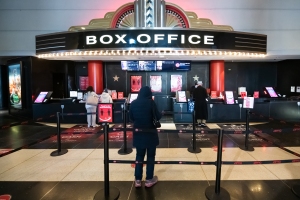UPDATED with NATO statement: Long in the works, and indicating stronger support for theatrical exhibition in the increasing age of streamers, the Board of the Academy of Motion Picture Arts and Sciences has approved a landmark change in eligibility rules for Best Picture.
Beginning with the 97th Academy Awards for films released in 2024, there are some significant added requirements for Best Picture eligibility after completion of the current initial qualifying run of a one-week theatrical release in one of six U.S. cities. These include:
- Expanded theatrical run of seven days, consecutive or non-consecutive, in 10 of the top 50 U.S. markets, no later than 45 days after the initial release in 2024;
- For late-in-the-year films with expansions after January 10, 2025, distributors must submit release plans to the Academy for verification;
- Release plans for late-in-the-year films must include a planned expanded theatrical run, as described above, to be completed no later than January 24, 2025;
- Non-U.S. territory releases can count toward two of the 10 markets;
- Qualifying non-U.S. markets include the top 15 international theatrical markets plus the home territory for the film.
AMPAS makes clear these new additional requirements are strictly for Best Picture and not for the other 22 categories, but of course Best Picture is the one just about everyone wants to be considered for.

Courtesy AMPAS
“As we do every year, we have been reviewing and assessing our theatrical eligibility requirements for the Oscars,” Academy CEO Bill Kramer and President Janet Yang said in a statement. “In support of our mission to celebrate and honor the arts and sciences of moviemaking, it is our hope that this expanded theatrical footprint will increase the visibility of films worldwide and encourage audiences to experience our artform in a theatrical setting. Based on many conversations with industry partners, we feel that this evolution benefits film artists and movie lovers alike.”
These new standards are a result of numerous conversations with various distributors of various sizes, and some in the exhibition community as well we hear. The ideas for it have been batted around for some time, and there were suggestions we hear for even longer qualifying runs for two or more weeks at one point during the discussions. How this will affect smaller or specialty distributors who tend to go slowly with their release patterns will be interesting to see. Sony Pictures Classics, for instance, often will qualify a film for a week in LA/NYC, reopen it on a limited basis in the new year and then slowly take it around the country. Everyone has their own release strategies, but these new rules certainly could affect them.

Jason Blum
Noam Galai/Getty Images for Tribeca Festival
Deadline originally learned several months ago of plans put forth even when Dawn Hudson was still CEO. It is an issue that seems to come up annually in one way or another. We hear that the current effort was instigated by members of the Producers Branch, with a charge led by AMPAS Producers branch governor Jason Blum and some others to make these changes in order to recognize that a core mission of the Academy is to support movies for the big screen, even as streamers such as Netflix, Apple, Amazon, Hulu and others have made huge inroads into the Oscar races in past seasons.

‘CODA’ wins Best Picture Oscar in 2022
Getty Images
Apple, in fact, became the first streamer to win Best Picture with its CODA victory last year and barely had any theatrical run when it first was released other than the bare minimum needed to qualify. This past March, Netflix — still looking for its first Best Picture win — likely came close with All Quiet on the Western Front scoring four wins, the largest total by any film other than eventual Best Picture winner Everything Everywhere All at Once from A24. That streamer generally will give longer exclusive pre-streaming limited theatrical runs of three to four weeks for select top Oscar hopefuls as it almost certainly will plan to do this year with Bradley Cooper’s Maestro and its Cannes pickup May/December from director Todd Haynes, among others.
With these changes, the Academy is hoping to reinforce its commitment to theaters and the unparalleled experience of seeing movies on the big screen, even as the organization admits that the way people watch movies continues to evolve.

(WireImage)
With much industry input in recent months, and key support from new AMPAS CEO Kramer, this plan was hatched to encourage theatrical distribution well beyond the minimums currently required for Best Picture, which is that eligible films must play theatrically for at least a week in one of six approved markets — New York, Los Angeles, San Francisco, Chicago, Miami or Atlanta — with some prime showtimes specified. Streamers cannot stream a film before it has a qualifying theatrical run but have been able to play online day-and-date after that requirement is met. In fact, even those minimal requirements were abandoned due to the pandemic but have now been fully reinstated and were in effect last year.
Now is the time to seize the moment and expand theatrical requirements after the upcoming — but not including — 96th Oscars, but as sources in favor of the move indicate, it is not to punish streamers but actually could help them as theatrical exposure is widely thought to give films more value in terms of visibility. As it is now for many films, including some very expensive ones, they get a nominal theatrical run in L.A. and New York, if that, and quickly wind up in “the larder” (as veteran director Paul Schrader once described it to me) with all the other programming, thus soon out of the spotlight a successful theatrical run offers. This push by AMPAS might ironically actually help increase their streaming success

Netflix
Streamers have been experimenting with a bigger theatrical footprint for this very reason. In November, Netflix opened Glass Onion: A Knives Out Mystery for a weeklong release in the three major exhibition chains (they labeled it as “previews”) that largely had avoided playing streamer product, before closing it and then bringing it to the service a month later. It went on to be Oscar-nominated for Best Adapted Screenplay.

Amazon jumped into theatrical in a bigger way earlier this spring with a 3,000-plus theatrical release of the Ben Affleck-directed Air several weeks before it began streaming and earned more than $50 million at the box office. Paramount and Apple are teaming up for an extensive theatrical run of Martin Scorsese’s Oscar hopeful Killers of the Flower Moon beginning in October with a limited run before expanding to wide release in theaters followed by streaming on Apple TV+ on an unspecified start date. It debuted in Cannes on May 20 to positive reviews. Sony Pictures is doing what Chairman Tom Rothman described at CinemaCon as a “robust” theatrical release of Ridley Scott’s epic, Napoleon in November which will then hit Apple streaming at a date to be determined.
With these new eligibility requirements the Academy seems to be doing its own thing in encouraging films to once again be seen in theatres, something that as the Motion Picture Academy inches toward its 100th anniversary in 2028, has been part of their DNA for much of that time, and now is being recognized once again, no matter how much the times they are a-changin’.
Michael O’Leary, President & CEO of the National Association of Theatre Owners, said today in a statement:
On behalf of the men and women who operate movie theaters across this nation, NATO applauds the Academy’s decision to require nominees for Best Picture to have a more substantial theatrical footprint beginning in 2025. We specifically want to thank Academy CEO Bill Kramer and Academy President Janet Yang for their leadership on this important initiative.
This decision recognizes that to be fully appreciated as the art form they truly are, motion pictures must be experienced as intended: in a theater full of people, on a big screen, with state-of-the-art projection, sound and lighting.
The Oscars are recognized by moviegoers around the world as the pinnacle of artistic accomplishment in motion pictures, and this important step, taken by the Academy, affirms that theatrical exhibition is the keystone of the industry. Simply put, the best movies in the world are at their best on the big screen.

